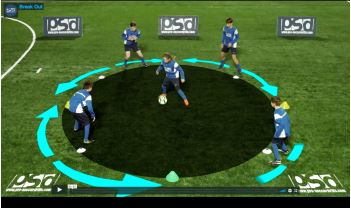Basics of the 4-4-2 Formation
4-4-2 Formation Setup
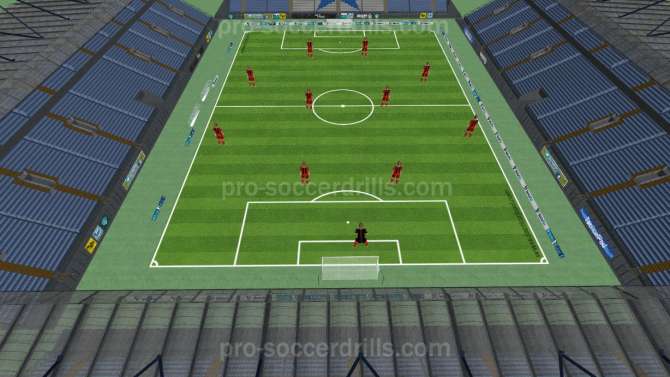
The 4-4-2 is one of the most common formation that coaches use. This formation consists of three lines: one back four, one midfield four and two strikers. The lines are usually using the unit that was developed by Arrigo Sacchi so they always have a pressure, a cover and a balance player in attack and in defence as well. The drawing above shows the most common 4-4-2 variation but many coaches use this formation with a diamond shape in the middle. In this article, we are going to go through the 4-4-2 line formation with its advantages and disadvantages, too. We are going to show the possibilities and opportunities coaches have when using this system of play.
The Back Four
The back four consists of four defenders, two central and two wide full backs that is the most common shape and setup in the world. Naturally, the roles could be different but this line of four helps a lot for the players in connection with the understanding of the game. This is the formation players see the most and the space here is separated the best way possible. This back four can be easily transformed into a back three or a back five so many ways.
- One option is that one of the central midfielders could step back and fill the gap between the two centre backs making a central back three.
- Another option, that’s not used that frequently is when a full back stays at the back leaving space for the wide player on his side to create possible 1v1 situations for him. This usually is the start of the process. (Graphics)
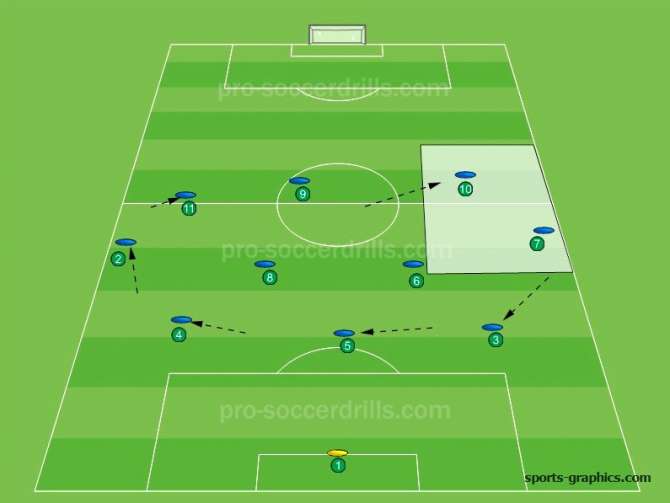
Let’s say that player number 3 stays at the back. This means the number 7 have more space next to the line for a possible 1v1 situation. This also lets the number 10 to go wide for some space. This can be really confusing for the opponent’s wide players because they have to make it clear who to mark and which spaces to fill.
In defence it is a very easy but effective formation and can be taught easily because there is the same line of four in midfield that the team has in defence.
The Midfield Four
In the 4-4-2 line formation the midfield four consists of two central midfielders and two wide midfielders. They also have the same roles as it was mentioned above.
The two central midfielders can be very different. Coaches can play with two hard-working players who play easy and have good physical qualities. These players have to be the connection between defenders and attackers so they have a lot of space to cover either in defence and attack. In attack the roles can be different as well, because one central midfielder can step back in defence to make a back three and have numerical advantage there. This also means that one central midfielder is missing, but gives a great chance for one striker to step back for the ball or a winger to take a step inside.
Coaches also have the opportunity to play with two holding midfielders whose task in attack is to keep the ball flowing and always give cover for the man on the ball. With two holding midfielders coaches can prepare well for any possible losing of possession.
The midfield four must always be strong and stable in the middle. As so many teams play with three central midfielders, the numerical advantage needs to be solved in defence and in attack. This is when a defender can step in or an attacker can step back.
The two wide players can also have different roles as they can step towards the inside or stay near the sideline. These variations can also be mixed depending on the quality of the players. But whenever a wide midfielder cuts in, there is usually a lot of space left on the flanks that can be filled by a central attacker or a full back.
In defence the central line of four has a really important task because - as it was mentioned just before - the opponents usually play with a central three in midfield. Numerical advantage can be solved two ways: one is when a striker comes back in midfield and starts man marking a free player and the other is when the line of four defends in a very compact way that they don’t leave space at all for the opponent.
This way there must be pressing triggers when the defending team should start putting pressure on the player on the ball and his passing options. In the 4-4-2 system it is usually in the centre, not like any other formations. It can be effective because the opponent might not play towards the outside because they don’t have free players there neither.
In every situation, the role of the two strikers/attackers are very important. They can make runs behind the opponent’s back line or can step back for the ball in the right moment to help the ball possession. This all depends on the quality of the payers and the coach’s tactics.
The Two Strikers
Most of the teams play with one central striker and possibly one additional player joins him in attack or maybe in defence. In this formation there are two central attackers to whom coaches can give different instructions.
Of course these players could be separated as well as they can stay together. Most of the times two floater strikers (kind of a false nine) is better because they are harder to follow for the opponent’s defenders.
The striker can stay in the centre to hold his position occupying one or two defenders distracting them from the game play. That’s a good idea to have one more fixed striker and a false nine that is more free to move on the pitch. He can step back for the ball to help the ball possession and by stepping back he also drags a defender out of his position. This gives good opportunities for deep runs for other players.
This is why the two central attacker should never be in line but they should be positioned diagonally. This diagonal can confuse the opponent’s defenders and make it harder for them to stick to their positions. As soon as a striker in the 4-4-2 is man marked he should look for a new space to occupy to drag the centre back out of his position.
There is space for the strikers to step back into midfield and also lots of space on the flanks to separate the two centre backs. If the ball is near the opponent’s goal, it’s always great to have a 2v2 situation in the middle because one attacker can be the pressure (or the man on the ball or the man going for the ball) and the other one can be a cover either making a run behind or preparing for the possible second ball. The diagonal positioning is always important for them.
Tactical Movements of the 4-4-2
PRESSING
The 4-4-2 is such a stable and compact system with clear roles and balanced positions on the pitch. Against possession-based styled teams it’s possible to put high pressure on the opponent in the middle as there is 2 to 4 players near the opponent’s goal according to the original line formation.
This is why 4-4-2 teams can press both of the centre backs of the opponent effectively. However this leaves a free man in midfield for the opponent so the pressing triggers must be very clear and the wide players should really understand that when the ball is on the far side, they need to step back and help the two centre midfielders picking up their players to man-mark.
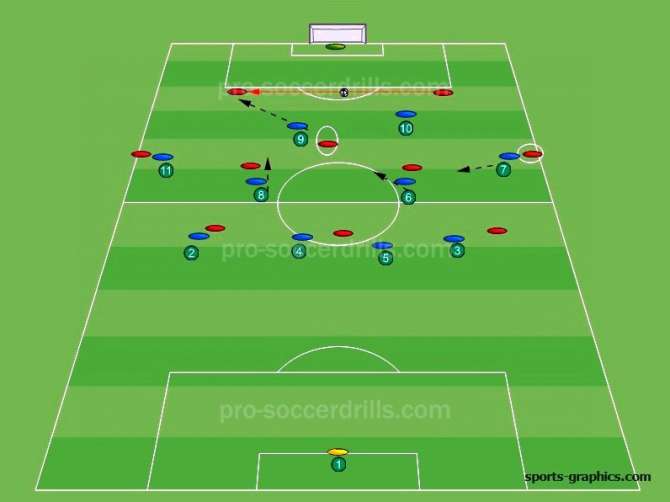
This way there is one free player in the middle that should be covered by both the attacker that’s making the jumping run and the central midfielder leaving his previous man. The defending team must be tight and organised before they start the pressing. 4-4-2 though needs time to get organised after a possible lost possession.
So the 4-4-2 line formation is really great for pressing the centre players of the opponents. If the opponent is playing with a back three, then the pressing trigger is when the ball goes out to one of the side centre backs. This way the pressing is started/triggered by the player who is attacking the middle centre back. This leaves two spare players on the far side but those passes are really risky for the opponent to make.
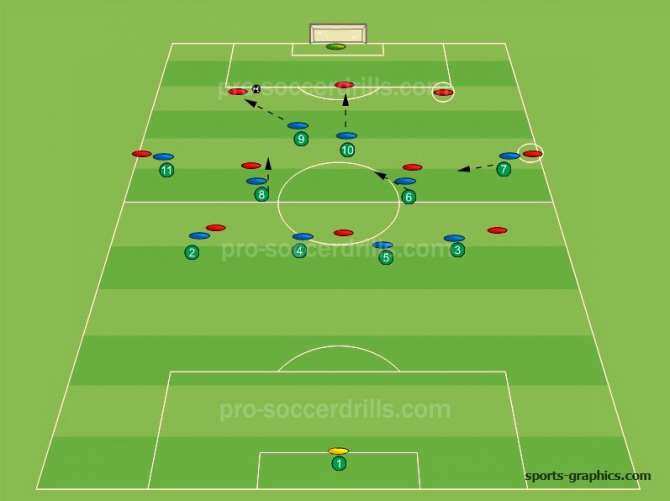
POSSESSION
In the 4-4-2 line formation there is usually a numerical advantage for the opponent in the middle. Although this formation is very stable in and out of possession, there should be plenty of way found to separate the opponents’ players and find a way to get behind them. Of course, there is almost always a 2v2 situation on the flanks so crossing situations can be really favourable for the team playing the 4-4-2. In the middle there must be constant interchanging movements, for example dragging the two centre backs out of their original position either with changing positions or just simply dragging the opponent to one side.
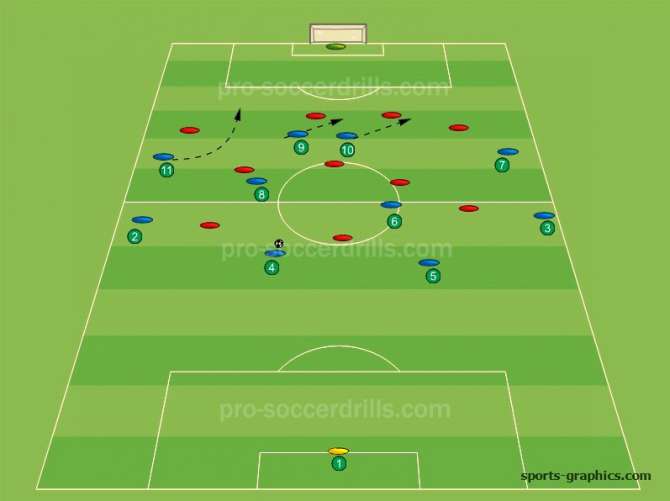
Organisation is key again but as this formation is very balanced, coaches must give 100% clear instructions to the players.
The strikers can step back, they can step towards the flanks and also stick to their positions. This defines the roles of the midfielders as well so coaches must choose wisely knowing his/her players and the opponent team.
Advantages and Disadvantages of the 4-4-2
ADVANTAGES
- Easy to practice (two lines of four)
- Balanced
- Plenty of attacking options
DISADVANTAGES
- Numerical advantage for the opponent in the middle
- Requires clever wide players in defence
Free Trial
GET YOUR FREE 14 - DAYS TRIAL NOW! INCLUDING:




